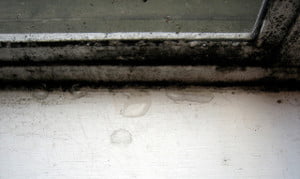How to Detect & Get Rid of Mould in Your Home

Mould problem can be a serious trouble in any home, no matter you are a homeowner or renter. This fungus grows on everything and prospers everywhere it can find moisture. It loves humidity, warm and dusk places and induces a musty, unpleasant odour.
A major mould infestation can ruin your home and your health. It doesn’t matter whether you have noticed a small spot of mildew in the bathroom or a larger chunk on an external wall.
Your first priority should be to eliminate it. The next most important thing is to find out what causes it and how to stop it from coming back.
That’s why the experts at the Star Domestic Cleaners Company have prepared the following guide to help you through.

What are Mould & Mildew
Mould and mildew (mould in its early stage) are fungi that easily and quickly grow anywhere there is moisture. They thrive on warm, moist, dark environments such as bathrooms or garage walls, woollen carpets or the outdoor furniture.
Both can spread on different surfaces in your home, including food, clothes, shower and even a piece of paper.
Note: To avoid fungi ruining your carpet or rug, the experts at Start Domestic Cleaners recommend professional carpet cleaning once every three months.
What are the Differences Between Mould & Mildew?
But mould and mildew differ when it comes to size, colour, and texture.
- Mould is a type of fungi that develops from airborne spores. It can be black or green coloured and often indicates larger infestation.
- Mildew is a surface fungus, type of mould, which is grey or even white tinted. It likes spreading across natural fabrics like cotton, linen and silk.
How to Detect if You Have Mould in Your Home?
Many of the properties provide the necessary conditions for mould to grow. A quick glimpse into your home may persuade you that you are safe. But you can not be sure without a detailed home inspection.
Unfortunately, a mildew problem is not always evident but we’ll teach you how to spot it at an early stage.
Here are some helpful tips for detecting if you have mould thriving in your home:
Check for Visible Growth
- Inspect your property thoroughly starting from the places with the highest humidity like your bathroom, basement and attic.
- Check the areas with inadequate airflow as corners and walls, all closets, windows and carpets.
If you ever see minor mildew patches, you should act immediately as they can spread quickly and will require more efforts to deal with.
Consider regular interior or exterior window cleaning to keep glass nice and shiny.
Do Not Ignore Strange Odours
Do any areas in your home smell disgusting or like rotten wood or paper? Often a weird odour might be the only signal for the problem. So do not ignore it, even if the signs of mildew are invisible.
Perform a nose check on the walls of your basement, bathroom, attic, and any other room prone to moisture.
Learn how to DIY: How To Get Dog Smell Out Of Your Carpet Naturally?
Check Water Leaks
As most of the leaks are often hidden, they can remain undetected for a long time which might make the problem even more severe.
If you have had water problems in your house such as leaking pipes or a leaking ceiling, that is enough of a clue that there is fungus growing in that places.
Pay Attention to Physical Symptoms
Do you notice if your allergy is getting worse when you are at home or outdoor?
Mould often inflict health issues because it contains mycotoxins that attack the skin, cause respiratory problems, and more. Typical allergic reactions to fungus include sneezing, sore eyes, a runny nose. It can cause asthma as well.
How to Get Rid of Mould
The sooner you face the mould problem, the easier it will be for you to tackle it. You can try to remove mould yourself using household products, or if you don’t have enough time for that chore, just ask for professional help.
If you choose the DIY method, make sure you are using protective gear, such as eyewear, face-mask and rubber gloves, and are following the tips below:
- Aerate the room where working – open windows or use a fan.
- Wear old clothing and wash it as soon as you finish cleaning in hot water to kill any spores that wind up on your clothes.
- Test the homemade mould cleaner on an invisible area before you use it on items.
How to Remove Mould from Walls
You can use a commercial mildew cleaning spray or prepare one with household products. Bleach is very efficient mould killer and it will be an essential part of your homemade spray.
Here is how to get rid of mould on walls:
- Mix a ¼ cup of bleach and 2 cups of warm water in a spray bottle.
- Scrub thoroughly the affected area with a clean cloth to remove the mildew.
- Wipe the wall using a clean cloth.
- Spray again If any mould remains.
- Let it sit for at least 15 minutes before scrubbing and wiping.
- Vacuum the room to get rid of residual spores.
How to Get Rid of Mould in Bathrooms
A bathroom provides the perfect conditions for mould to grow, such as the hot and humid environment, especially post-shower or bath. To completely get rid of mould, you have to not only clean it away but you must also kill it.
Here is a great cleaning solution for removing mould in your bathroom naturally that takes no effort to make:
- Mix 3% hydrogen peroxide and a little bit of white vinegar in a dark spray bottle. Shake it well!
- Do a spot test on the surface where the mould is thriving to make sure the solution won’t cause the surface to fade.
- Spray the affected area thoroughly and let the solution sit for an hour.
- Wipe up the surface with a clean, damp cloth.
NOTE: That bathroom mould removal is effective when it comes to getting rid of mildew on walls, tiles and ceilings.
How to Get Rid of Mould on Fabrics
The fungus can often grow on clothes, and organic fabrics provide a food source for it to thrive. So you can be sure that if you notice mould on one shirt, it will hop on everything within the wardrobe in no time.
Gratefully, you can remove mould from your fabrics via the tips below:
- Check care labels – follow the manufacturer instructions about the appropriate water temperature for your garment and how it should be dried.
- Scrub the visible mould stain off with a brush with medium bristle hardness so you don’t ruin the fabric.
- Apply a solution of equal parts white vinegar and water using a white cloth.
- Laundry the garment in your washing machine at the highest hot setting.
- Let it air dry. Hang it up outdoors as sunlight is a great natural mildew-killer.
NOTE: To prevent mould coming back on your clothes, make sure to protect your closet using a mould spray. You should empty your wardrobe before spraying it so that is a perfect time to declutter it (learn how best to organise your closet).
When left unchecked, mould and mildew can also ruin a leather recliner or chair. The good news is, you can clean new leather recliners in a similar way you would fabric: mix one part white vinegar and one part water in a bowl, then add rubbing alcohol and spray it onto a cloth to wipe the chair.
A top tip: Make sure to move the recliner or leather chair out of direct sunlight after you’ve cleaned it and keep a fan on it to dry.
Fungi can even infest drapery. Just make sure you check if your curtains are suitable to wash or dry clean only.
If nothing works, resolve to our proven service for professional upholstery cleaning.
How to Get Rid of Mould Smell in Your Home
A mould infestation is always accompanied by an unpleasant damp smell that makes your home feel less welcoming. If you have already detected the mildew and removed it completely, it’s time to get rid of the musty smell for good. Just follow the tips below:
- Open up all doors and windows to let the fresh air pour in. Don’t forget to open up confined spaces like closets, cupboards and cabinets.
- Use some baking soda to absorb the damp smell and moisture in small shut-in areas like cabinets, closets. Put a plate with bicarbonate of soda for up to 24 hours.
- Make a natural lemon air freshener – mix 1 tablespoon squeezed lemon juice, 1 teaspoon baking soda, 2 cups warm water and 7 drops lemon essential oil in a spray bottle. Shake it to dissolve the baking soda and spray when needed to achieve fresh lemon scent.
Read our full guide:
How to Get Rid of Damp and Musty Odours at Home?
How to Prevent Mould Coming Back
If you want to prevent it from returning, you need to get to the bottom of the problem. It is important to find out what is causing dampness in your property and to take precautions.
Eliminate Moisture
Mould and mildew like warm, humid, dark spaces. If you want to forget for them, you have to find out what helps them grow at a first place. Try to control your home’s indoor humidity down:
- Use a dehumidifier, air purifuier or an air-conditioner.
- Use a heater if the house is damp.
- Place silica gel packets on a closet shelf to absorb moisture in your wardrobe.
Vent your Property Regularly
To have a mould-free home, you have to keep it well-ventilated. The ventilation is an enemy of moisture.
There are some good practices you can follow:
- Always use an extractor fan when you take shower or cook.
- Keep your windows open when the weather allows it.
- Invest in a high-quality dehumidifier.
- Dry your clothes outside or use a tumble dryer.
- Control smoky atmospheres.
Fix Water Leaks & Gutters
According to Plumbing Lab, plumbing leaks and broken gutters are some of the most common reasons for mildew to spread. To stop the problem from reoccurring, it is important to fix them as soon as possible.
Gutters keep water away from your house, so maintain them regularly. Clean them every fall and spring to remove dirt, debris and leaves.
Keep Your Home Fresh & Clean
To keep your property fresh, healthy and mould-free, you have to maintain it regularly. Cleaning, sanitizing and disinfecting prevent mould growth.
So it is essential to give your home a thorough clean-up at least once a month or for a better result do it on weekly basis. In case you don’t want to spend your free time dusting or scrubbing, you can arrange a professional regular cleaning to successfully keep your home in tip-top shape.

Contact us for professional help.
Credits:
Header image source: Flickr. Title: “Black Mold”. Author: satemkemet. License type: CC BY-SA 2.0



